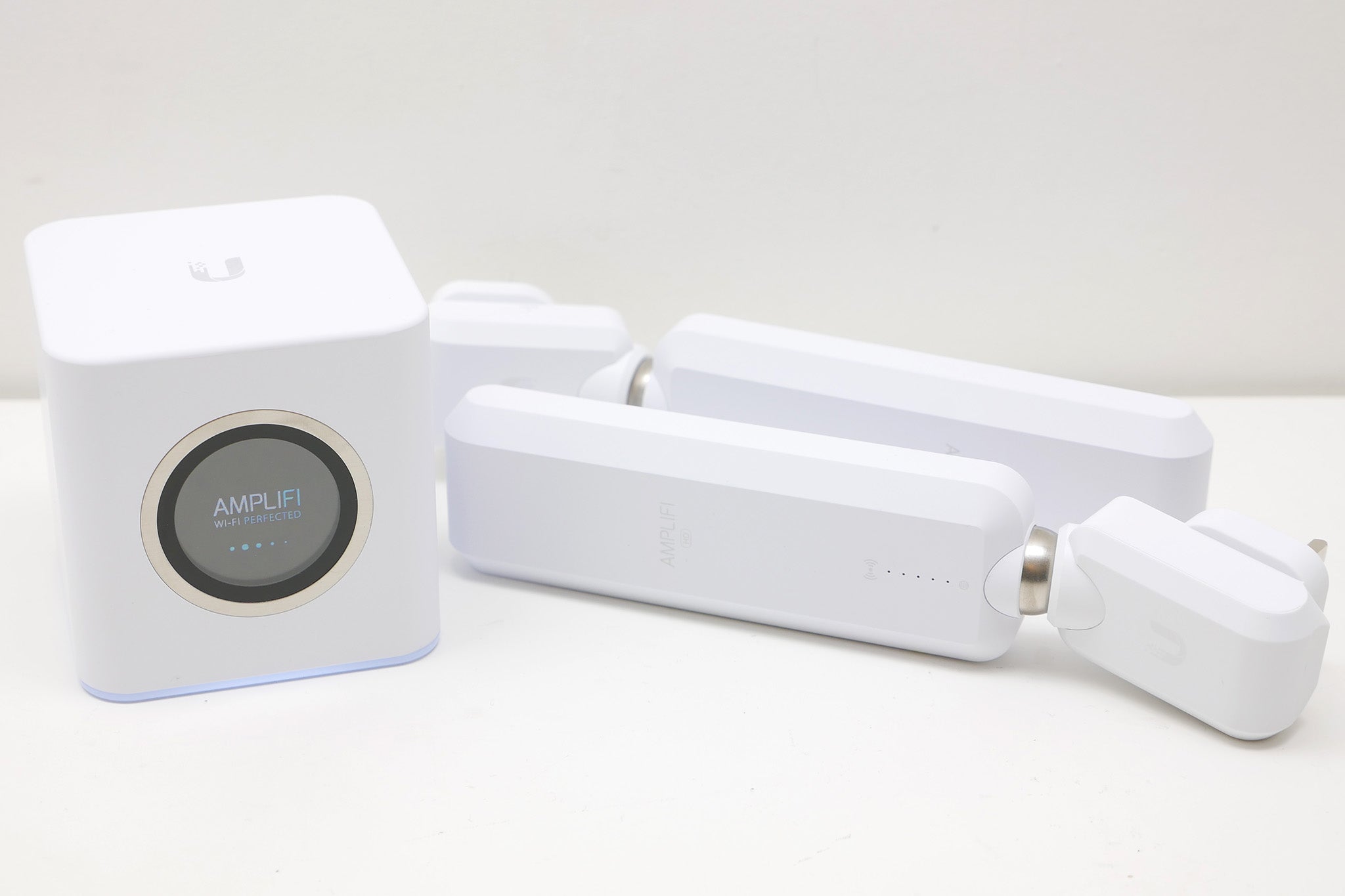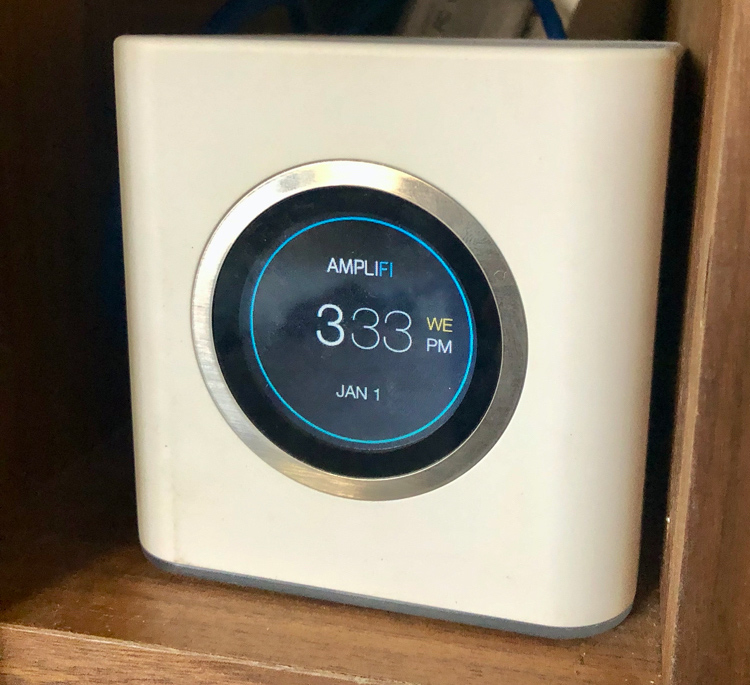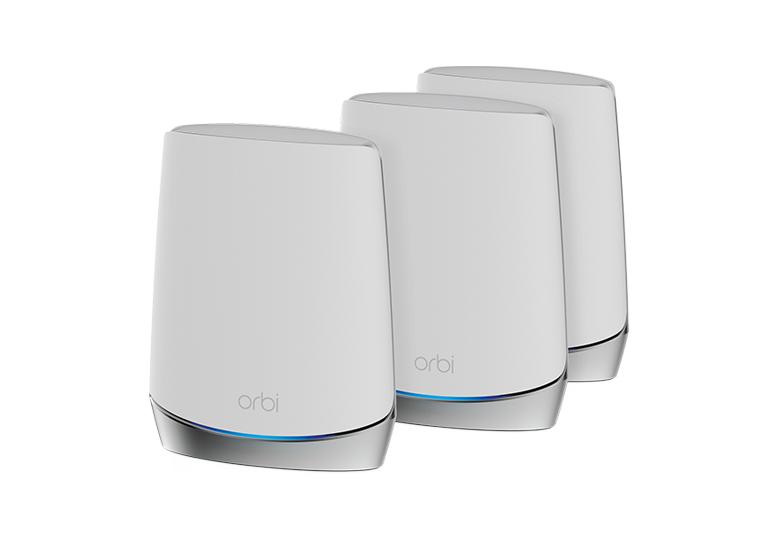Ubiquiti Amplifi Review

Ubiquiti Amplifi Alien Overview And Features
As far as naming goes, Alien is an apt name for this router. The router has a 250mm profile, which is quite tall. This includes ASUS’s arachnid monstrosity. The Alien looks less like a router and more like a beefed-up Echo Plus (opens in new tab) with a matte finish — there’s even a light ring, albeit at the bottom.
You can see the network activity on Alien’s large display.
The standout design feature on the Alien is the LCD screen. This 4.7 inch panel displays real-time bandwidth information, resource consumption, and all devices attached to the network at a glance. It has a resolution 274×1268.
The screen of the Alien is a great option for someone who uses a Pi 4 monitor to check the bandwidth usage on their home network. The screen is easy to use to view the router’s status. It also has the touchscreen option that allows you to scroll through the settings of the router and all devices connected to it. You can even run a test to determine your bandwidth.
An LED light ring that glows green at the bottom of the Alien is included. This particular color is associated with NVIDIA and I have been trained over two decades to recognize it as such. There’s also a built-in speaker that gives audible alerts whenever the router boots up and if the internet goes down.
If you don’t like bright lights coming from your router, then adjust its intensity or switch it off completely. You can also adjust the brightness of the screen itself and schedule both the LED light ring and screen to turn off at night.
The back has four Gigabit Ethernet LAN port and one WAN port. The LAN ports face vertically and the WAN port can be found in the base near the power socket. It’s not important that there is a USB port in this area.
The Alien setup is easy and should take less than 5 minutes. You just need to plug the modem cable into the router’s WAN port. Next, download the Ubiquiti AmpliFi Wi–Fi app (opens new tab) from the Play Store. You can set the router’s SSID, password and configure options based upon your service provider.
Ubiquiti’s AmpliFi Teleport function is an innovative addition that really makes the Alien standout.
Once you set things up, the AmpliFi dashboard gives you an overview of the router’s connectivity status, connected devices, real-time bandwidth usage, and the ability to adjust wireless settings. It is designed for the general user, but what it does not have in terms of advanced features such as setting up VPN servers or setting up VPN servers — it makes up in simplicity. The interface consists of five tabs: Overview, Performance, Guest, Devices, and Diagnose.
You can access the settings page for a satellite or router’s device from the overview tab. This tab also shows you the current usage and number of devices. You can change the name of your network, assign new SSIDs to each band, use band steering to prioritize the 5GHz band (which has less range but delivers more throughput), set up a custom DNS server and configure port forwarding, use the router in bridge mode, and adjust the brightness of the router’s screen and LED light ring.
You can view bandwidth usage statistics starting at the beginning of your router’s use. The Performance tab also allows you to run bandwidth tests in order to determine connectivity. The guest tab allows you to create a guest network and see all devices. You can also prioritize traffic, pause or suspend the internet on a specific device.
My favorite feature on the Alien is Teleport. The feature is available on all AmpliFi devices, and it essentially lets you connect to your home Wi-Fi network when you’re traveling. Now I know that international travel feels like a laughable idea, but I see this coming in handy once things normalize, and we’re able to travel again.
Teleport creates a tunnel from your Wi-Fi network to Teleport, which is essentially a private VPN network. You’ll have access to the Netflix and Prime Video catalogues even if you are abroad using Teleport. Teleport also works well when connected to public Wi-Fi networks. All data transmitted over Teleport are encrypted. You will need the Teleport app to be downloaded from the Play Store.

Ubiquiti Amplifi Instant Review
Ubiquiti AmpliFi Instant is a router with a touchscreen and one WAN port. One 1GB Ethernet cable. An Ethernet port. A Mesh Point has one Ethernet port. This allows you to maximize coverage, eliminate dead spots, and reduce the number of wires.
The Wi-Fi system provides great coverage up to 4000 sq. feet and a quick set-up for continuous coverage throughout your home.
The AmpliFi Instant has a powerful and efficient antenna that allows for extra throughput and additional capacity for MIMO or Multi Input – Multi Output. MIMO allows devices to communicate using multiple streams, which allow you to transfer more data at once.
The AmpliFi Instant from Ubiquiti is a very neatly and cleanly designed product with both its main router and secondary Mesh Point that consists of clean white lozenges that measure 98 x 100 x 33 millimeters (W x D x H).
The Instant Router’s one-piece section contains an Ethernet port that can be used to connect to your primary router or modem, as well as a USB AC adapter and a passthrough port which you can use to hard wire another device. The router’s front panel has a touchscreen which displays time and date as well as status.
On one of the sides of the mesh device, you’ll see one Ethernet port that lets you hardwire the USB AC port and an additional device. An LED light runs around the entire base of every component’s bottom.
The Mesh Point and router are almost identical and the only difference between the two is the lack of a WAN port and screen on the latter.
Aesthetics play a huge part in the AmpliFi Instant since these are designed to be displayed and not hidden in a corner cabinet, or at the far end of your desk. This is device is created specifically for your tabletop and should fit perfectly with any contemporary decor or theme.
Displaying it is also a better option, since the LCD screen on router provides quick information on upload and download speeds. You can even set it to turn itself off at night using the AmpliFi App.
Both of these devices from Ubiquiti are solidly built, but of course, there are some signs of cost-cutting since the company aimed to keep it affordable. The primary router has only two Gigabit Ethernet ports. One must be connected to the router’s current router in order to have internet access. For the Mesh Point it is one port.
We recommend that you choose another product that has more Ethernet ports if you need a wired connection to multiple devices, such as smart TVs and game consoles. It’s still an excellent product by Ubiquiti in terms of performance and functionality.
Both of the units make use of a USB C port to provide power supply to their main, though keep in mind that there are no extra USB ports to let you share a hard drive or printer with others on your home network.

Ubiquiti Amplifi Interface and Setup
It is very easy to set up AmpliFi. The AmpliFi can be purchased as a complete kit. Simply plug the router in and connect to it automatically.
If this was up your alley, you might appreciate
Google Wifi Ac1200 Review
For configuration, you can use either a web browser or the AmpliFi app. For the former, simply connect to its Wi-Fi network or one of its LAN ports, then browse to 192.168.187.1. For the latter, download the app, connect your phone to the default Wi-Fi, open the app and follow the instructions.
Similar: Wi-Fi Extenders that Work
It’s good, then, that the app is fast and easy to use. The app’s top has five tabs, which correspond to the general settings, throughput and guest networks, as well as user access, status, and other information.
Working backwards, the user access tab shows each connected device and allows you to pause internet access for it. You can also pause internet access on all connected devices.
If this resonated with you, you might also enjoy
Orbi Wifi 6 Review
You can turn on the guest network to allow you to choose the number of devices that can be connected to it. Additionally, the guest network allows for access to the Wi-Fi settings.
The router’s throughput is the actual time and the total throughput. You can also perform an ISP speed check from this page.
You can turn the LED or display off/on/down, as well as turning on/off a night mode that turns them off by themselves. You can adjust the volume and time zones as well as the sound of the speaker built in (which beeps when you touch the screen or make other adjustments via the app). You can change the Internet access type DHCP or static as well as PPPoE.
The most remarkable addition is the ability to disable band-steering. This is the technical term for the technology that enables the system to present only a single Wi-Fi SSID, rather than one for each band; normally with mesh systems, there isn’t an option to turn it off.
What’s more, Ubiquiti has chosen to add a separate option to explicitly name the SSID for each Wi-Fi band something different. The router will rename both bands automatically to something else if band-steering has been turned off. However, this is a different option.
There’s also a router-steering option that directs devices to connect to the router, rather than any mesh points. The benefits of doing this are unclear, given that there are no further options to configure how this works.
This is not a professional or power user set. The AmpliFi offers the absolute basics, which almost all home users will need, but the system is a far cry from the more comprehensive options available on the company’s Unifi products.

Ubiquiti Amplifi Hd Design And Features
The AmpliFi HD sets itself apart from the competition with a unique design for both the main router and the nodes, which here are branded as MeshPoints. The boxy router is mainly white with a soft-touch finish, it has an adjustable LED underglow, and there’s a rather large touchscreen in the middle that can be used for simple controls as well as displaying the current time or internet speeds. As far as routers go, it’s one of the nicest I’ve seen, and even without external antennae, it performs quite well on its own.
AmpliFi HD is unique in design. It’s easy to set up and offers great range and performance.
The MeshPoints are a different story. They’re made up of two parts with a magnetic joint in the middle. The bottom piece plugs into a wall socket, and the top piece acts as an antenna which can be pointed in the general direction of the main router or, say, the desk in your office. The MeshPoints have the same soft-touch paint on them, and they are aesthetically pleasing, but they’re a bit bulky to have hanging off your wall. They will look out of place if you can’t hide them behind anything.
You will find a WAN port to connect back to your modem, and four Gigabit LAN ports that can be used for other wired devices. The router could only access full Gigabit speeds when it was set up in bridge mode. However, this issue seems to be resolved by a firmware upgrade. On the back is also a USB-A port that doesn’t do anything — which is a real sore spot for AmpliFi owners — and a USB-C port that’s used for powering the device. As for the MeshPoints, there are no ports. For this reason, wired backhaul is not possible, so you’ll have to rely on wireless unless you opt for two main routers rather than the router and MeshPoint setup.
If you were a fan of this, you might also be into
Netgear Nighthawk Ax1800 Review

